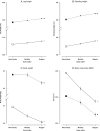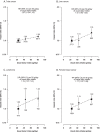Dairy consumption and risks of total and site-specific cancers in Chinese adults: an 11-year prospective study of 0.5 million people
- PMID: 35513801
- PMCID: PMC9074208
- DOI: 10.1186/s12916-022-02330-3
Dairy consumption and risks of total and site-specific cancers in Chinese adults: an 11-year prospective study of 0.5 million people
Abstract
Background: Previous studies of primarily Western populations have reported contrasting associations of dairy consumption with certain cancers, including a positive association with prostate cancer and inverse associations with colorectal and premenopausal breast cancers. However, there are limited data from China where cancer rates and levels of dairy consumption differ importantly from those in Western populations.
Methods: The prospective China Kadoorie Biobank study recruited ~0.5 million adults from ten diverse (five urban, five rural) areas across China during 2004-2008. Consumption frequency of major food groups, including dairy products, was collected at baseline and subsequent resurveys, using a validated interviewer-administered laptop-based food frequency questionnaire. To quantify the linear association of dairy intake and cancer risk and to account for regression dilution bias, the mean usual consumption amount for each baseline group was estimated via combining the consumption level at both baseline and the second resurvey. During a mean follow-up of 10.8 (SD 2.0) years, 29,277 incident cancer cases were recorded among the 510,146 participants who were free of cancer at baseline. Cox regression analyses for incident cancers associated with usual dairy intake were stratified by age-at-risk, sex and region and adjusted for cancer family history, education, income, alcohol intake, smoking, physical activity, soy and fresh fruit intake, and body mass index.
Results: Overall, 20.4% of participants reported consuming dairy products (mainly milk) regularly (i.e. ≥1 day/week), with the estimated mean consumption of 80.8 g/day among regular consumers and of 37.9 g/day among all participants. There were significant positive associations of dairy consumption with risks of total and certain site-specific cancers, with adjusted HRs per 50 g/day usual consumption being 1.07 (95% CI 1.04-1.10), 1.12 (1.02-1.22), 1.19 (1.01-1.41) and 1.17 (1.07-1.29) for total cancer, liver cancer (n = 3191), female breast cancer (n = 2582) and lymphoma (n=915), respectively. However, the association with lymphoma was not statistically significant after correcting for multiple testing. No significant associations were observed for colorectal cancer (n = 3350, 1.08 [1.00-1.17]) or other site-specific cancers.
Conclusion: Among Chinese adults who had relatively lower dairy consumption than Western populations, higher dairy intake was associated with higher risks of liver cancer, female breast cancer and, possibly, lymphoma.
Keywords: Cancer; China; Dairy products; Diet; Prospective cohort study.
© 2022. The Author(s).
Conflict of interest statement
The authors declare that they have no competing interests.
Figures



Similar articles
-
Red meat, poultry and fish consumption and risk of diabetes: a 9 year prospective cohort study of the China Kadoorie Biobank.Diabetologia. 2020 Apr;63(4):767-779. doi: 10.1007/s00125-020-05091-x. Epub 2020 Jan 22. Diabetologia. 2020. PMID: 31970429 Free PMC article.
-
Alcohol drinking and risks of total and site-specific cancers in China: A 10-year prospective study of 0.5 million adults.Int J Cancer. 2021 Aug 1;149(3):522-534. doi: 10.1002/ijc.33538. Epub 2021 Mar 9. Int J Cancer. 2021. PMID: 33634874 Free PMC article.
-
Socioeconomic Status in Relation to Risks of Major Gastrointestinal Cancers in Chinese Adults: A Prospective Study of 0.5 Million People.Cancer Epidemiol Biomarkers Prev. 2020 Apr;29(4):823-831. doi: 10.1158/1055-9965.EPI-19-0585. Epub 2020 Jan 27. Cancer Epidemiol Biomarkers Prev. 2020. PMID: 31988070 Free PMC article.
-
Dietary Patterns and Breast, Colorectal, Lung, and Prostate Cancer: A Systematic Review [Internet].Alexandria (VA): USDA Nutrition Evidence Systematic Review; 2020 Jul. Alexandria (VA): USDA Nutrition Evidence Systematic Review; 2020 Jul. PMID: 35129907 Free Books & Documents. Review.
-
Folic acid supplementation and malaria susceptibility and severity among people taking antifolate antimalarial drugs in endemic areas.Cochrane Database Syst Rev. 2022 Feb 1;2(2022):CD014217. doi: 10.1002/14651858.CD014217. Cochrane Database Syst Rev. 2022. PMID: 36321557 Free PMC article.
Cited by
-
Cheese consumption and multiple health outcomes: an umbrella review and updated meta-analysis of prospective studies.Adv Nutr. 2023 Sep;14(5):1170-1186. doi: 10.1016/j.advnut.2023.06.007. Epub 2023 Jun 15. Adv Nutr. 2023. PMID: 37328108 Free PMC article.
-
Enrichment of C17:0-rich saturated fatty acids from sheep tail fat for adjuvant therapy of non-small-cell lung cancer.Food Sci Biotechnol. 2024 Jan 23;33(8):1947-1956. doi: 10.1007/s10068-023-01504-w. eCollection 2024 Jun. Food Sci Biotechnol. 2024. PMID: 38752121 Free PMC article.
-
Association between non-skimmed milk consumption and metabolic dysfunction-associated fatty liver disease in US adults: insights from NHANES data.BMC Gastroenterol. 2025 Apr 18;25(1):270. doi: 10.1186/s12876-025-03834-x. BMC Gastroenterol. 2025. PMID: 40251472 Free PMC article.
-
Associations of intakes of total protein, protein from dairy sources, and dietary calcium with risks of colorectal, breast, and prostate cancer: a prospective analysis in UK Biobank.Br J Cancer. 2023 Sep;129(4):636-647. doi: 10.1038/s41416-023-02339-2. Epub 2023 Jul 5. Br J Cancer. 2023. PMID: 37407836 Free PMC article.
-
Sex steroid hormone residues in milk and their potential risks for breast and prostate cancer.Front Nutr. 2024 Sep 2;11:1390379. doi: 10.3389/fnut.2024.1390379. eCollection 2024. Front Nutr. 2024. PMID: 39285863 Free PMC article. Review.
References
-
- Global Cancer Observatory: Cancer today [Internet]. International Agency for Research on Cancer. 2020. Available from: https://gco.iarc.fr/today. [Accessed on 22 February 2022]
-
- World Cancer Research Fund/American Institute for Cancer Research. Meat, fish and dairy products and the risk of cancer. Continuous Update Project Expert Report 2018.
Publication types
MeSH terms
Grants and funding
- MC_U137686851/MRC_/Medical Research Council/United Kingdom
- 29017/CRUK_/Cancer Research UK/United Kingdom
- 212946/Z/18/Z/WT_/Wellcome Trust/United Kingdom
- 29186/CRUK_/Cancer Research UK/United Kingdom
- 205212/Z/16/Z/WT_/Wellcome Trust/United Kingdom
- MC_UU_12026/2/MRC_/Medical Research Council/United Kingdom
- MC_EX_G0801669/MRC_/Medical Research Council/United Kingdom
- MC_UU_00017/1/MRC_/Medical Research Council/United Kingdom
- CH/1996001/9454/BHF_/British Heart Foundation/United Kingdom
- MC_PC_12027/MRC_/Medical Research Council/United Kingdom
- MC_U137686854/MRC_/Medical Research Council/United Kingdom
- MC_PC_12029/MRC_/Medical Research Council/United Kingdom
- G0300622/MRC_/Medical Research Council/United Kingdom
- MC_PC_12028/MRC_/Medical Research Council/United Kingdom
LinkOut - more resources
Full Text Sources
Medical

